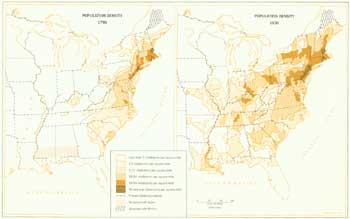





Historical Background
Toward the Setting Sun—The Westward Movement, 1783-1828
At the end of the War for Independence, the West was the land between the Appalachian Mountains and the Mississippi River. To the south and southwest of the United States the flag of Spain fluttered over long-established posts and settlements in Florida, New Orleans, Texas, and the Far West. In the forests of the Ohio country, which the British had not yet abandoned, scattered stockades displayed the Union Jack. The few thousand Indians, trappers, traders, and subsistence farmers living in the West in 1783 made little imprint on the land. It was still mostly wilderness.
During the next two generations, the Spanish, the British, the Indians, the forests—all retreated before waves of emigrating Americans. In 1803 the Louisiana Purchase doubled the size of the Nation. By 1830 the population west of the Appalachians was nearly equal to that of the entire United States in 1783. Most of the wilderness east of the Mississippi had been carved into States. Turnpikes and canals linked many of the cities. Towns and prosperous farms dotted the landscape. In less than half a century, the "West" had come into being and changed the character and political balance of the Nation. A political power in its own right, it was wooed by North and South. It also provided the base for the further westward thrust toward the Pacific.
The settler's desire for land was insatiable. By 1828 the frontier had reached the Mississippi River, and in the Missouri region it had pushed far beyond. Settlers were moving into Arkansas and Texas. Before long they would cross the "Great American Desert" on their way to Oregon and California. The fur traders and trappers led the way. In search of beaver, they explored parts of the Southwest, the Rockies, the Dakotas, and as far west as the Pacific coast. They opened new trails, and gathered important information on geography, flora and fauna, and the native peoples. Yet the days of the far western migration still lay ahead.
The precise influence of the West on national institutions is difficult to define. To some, the frontier—the successive zones where civilization and wilderness met—symbolized self-reliance, individualism, and democracy. To others, it epitomized savagery and lawlessness. The truth lies somewhere between these extremes. The frontiersman certainly learned to be self-reliant or he did not survive, but he also learned something about getting along with his neighbors. The impact of the West on the growth of democracy is debatable. Frontier conditions tended to blur social distinctions and demand that a man be judged by what he could do rather than by who he was. The constitutions of each new State seemed more democratic. Yet democratic ideas were not unique to the West. That they found reflection in Western State constitutions occurred in part because the westerners could start fresh when they wrote their constitutions—though usually they copied in large measure those of the older States, where entrenched interests were well equipped to resist change.
 |
| Principal Roads to the West and Canals (as of 1830) (click on image for an enlargement in a new window) |
DREAMS, OPPORTUNITIES, AND REALITIES
Who were the people who went West? Where did they come from—and why? Some were immigrants from Europe. The first wave of German and Irish immigration began in the 1820's. But the majority of the emigrants were farmers, planters, and agricultural workers from the Eastern States. For a time after the War of 1812, the exodus even decreased the population of some States, such as Connecticut and Maryland.
No single factor explains the westward migration, nor was it an organized, coherent movement. Each migrant had his own reasons for making the journey. Cheap land was a magnet. Land prices in the East, particularly in New England after the War of 1812, were rising and good land was becoming scarce. In the South, soil exhaustion—from the repeated planting of crops such as tobacco—caused the uprooting of planters and farmers.
Frustrations—political, social, religious, and economic—and the desire for adventure motivated some to risk the uncertainty of life in a different environment. Others were misfits—outcasts from civilization—and some were fleeing debts in the East. But most were ordinary citizens. For all, except the slaves, who had no choice in the matter, the westward journey was in some way a fresh start, a chance to begin again, and perhaps to do better.
 |
 |
http://www.cr.nps.gov/history/online_books/founders-frontiersmen/intro18.htm
Last Updated: 29-Aug-2005